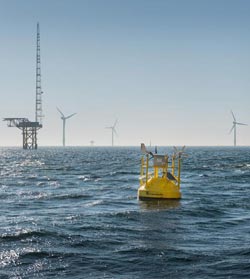Floating LiDAR System starts North Sea Measuring Operations

The Fraunhofer IWES’ LiDAR wind-measuring buoy was successfully installed near the FINO1 meteorological mast. The buoy measures wind speeds at heights of 40 to 200 m.<br>Photo: Fraunhofer IWES<br>
Wind speed information greatly improves risk minimisation in the planning, construction and operation phases of offshore wind farms. When compared with measuring masts, the buoy has one decisive advantage:
It can be employed at any location with no extra installation costs and requires a less time-consuming authorization procedure. This is all made possible by a correction algorithm developed at the Fraunhofer IWES.
A validated technology conquers new terrain: Using LiDAR (“Light Detection And Ranging”) appliances on land and on fixed platforms for measuring wind speeds at heights of 40 to 200 m are a proven process. Proper motion, which falsifies measurement values taken from moving surfaces, has hitherto hindered the reliable employment of LiDAR applications offshore. Within the framework of the project “Offshore Measuring Buoy” – funded by the German Federal Ministry for the Environment – Fraunhofer scientists are now extremely excited about the first North Sea deployment of the gloating LiDAR system. A Windcube LiDAR device made by the company Leosphere has been integrated into the buoy.
Rapid implementation and marked cost reductions through floating LiDAR technology should make it possible for wind farm developers to reduce the actual costs of offshore wind energy. The construction of an authorized measuring mast such as FINO1 requires a double-digit million investment. The data quality of mast and buoy should be comparable.
High Data Quality Despite Floating Platform:
The buoy will remain in the North Sea until October to prove its offshore suitability and to allow a validation of measurement accuracy using comparisons with the measurement data from the stationary mast. “A system for measuring buoy movement in combination with a correction algorithm, developed at the Fraunhofer IWES, is the key ingredient of this technology. In this way, high quality wind measurement data can be assured from a moving platform,” explains IWES Project Leader Dr. Julia Gottschall.
Cost Reduction in every Expansion and Operations Phase:
Using a floating LiDAR system, the provisions of offshore wind resources are followed exactly and reliably – also in the long term and at greater water depths. Considerable time and cost advantages compared with measuring masts and flexible application potentials are the main arguments for the deployment of mobile systems. Exact determination of weather windows during the installation phase allows reliable planning of individual construction steps. Accompanying measurements during operations allow statements concerning turbine efficiency and potential wind energy yield.
Further information:
Dr. Julia Gottschall
Phone +49 471 14290-354
julia.gottschall@iwes.fraunhofer.de
Media Contact
More Information:
http://www.iwes.fraunhofer.deAll latest news from the category: Power and Electrical Engineering
This topic covers issues related to energy generation, conversion, transportation and consumption and how the industry is addressing the challenge of energy efficiency in general.
innovations-report provides in-depth and informative reports and articles on subjects ranging from wind energy, fuel cell technology, solar energy, geothermal energy, petroleum, gas, nuclear engineering, alternative energy and energy efficiency to fusion, hydrogen and superconductor technologies.
Newest articles

NASA: Mystery of life’s handedness deepens
The mystery of why life uses molecules with specific orientations has deepened with a NASA-funded discovery that RNA — a key molecule thought to have potentially held the instructions for…

What are the effects of historic lithium mining on water quality?
Study reveals low levels of common contaminants but high levels of other elements in waters associated with an abandoned lithium mine. Lithium ore and mining waste from a historic lithium…

Quantum-inspired design boosts efficiency of heat-to-electricity conversion
Rice engineers take unconventional route to improving thermophotovoltaic systems. Researchers at Rice University have found a new way to improve a key element of thermophotovoltaic (TPV) systems, which convert heat…



